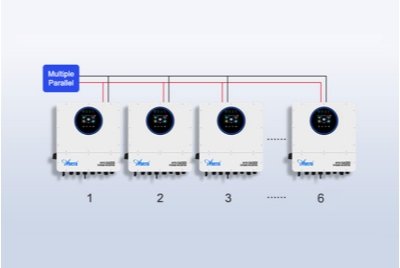What Advanced Inverter Features Maximize My Energy Independence?
Nov 13, 2025
If you are researching solar, you're already familiar with the term "Hybrid Solar Inverter." It's the traffic controller for your energy, managing power from your panels, battery, and the grid. It has become the standard for modern solar systems.
But once a product becomes "standard," the real difference isn't if it's a hybrid, but what else it can do.
Today's inverters are the intelligent brains of the system. The difference between a cheap, basic model and an advanced one directly dictates your comfort during an outage, your savings on the monthly bill, and the longevity of your system.
1. Monitoring & Control: Is My System 'Coasting'?
One of the most common forms of "buyer's remorse" in solar is installing an expensive system and having no idea if it's working optimally. Are you generating what you should be? Did you use expensive grid power during peak hours, or did you intelligently use your stored battery power?
Without data, you are flying blind.
This is why Smart Remote Management Inverter has become a critical feature. For instance, a Wifi-Communicated Hybrid Solar Inverter does more than just convert power; it's a data hub that pushes real-time performance to your phone or PC via your home's Wi-Fi.
Traditional Monitoring vs. Smart Remote Management
Evaluation
Traditional Inverter (No Comms)
Wifi-Communicated Inverter
Performance View
Must physically check the small screen on the inverter.
Real-time app (Generation, Consumption, Battery Status).
Fault Diagnosis
You find out when the system stops working (often too late).
Instant fault alerts and remote diagnostics.
Mode Switching
Requires manual button-pressing at the unit.
Change settings remotely via app (e.g., set discharge for nighttime).
Data Analysis
No historical data.
Detailed daily/monthly/yearly reports to optimize usage.
With this level of smart inverter remote management, you can actively decide whether to sell excess power back to the grid or charge your battery before peak rates kick in.
2. Resilience: What Happens in a Blackout or Bad Weather?
An inverter is a sophisticated piece of electronics. Where is it installed? And how does it react under pressure (like an outage)?
A) Environmental Resilience (IP65)
Many installers put inverters in a garage for convenience. But for homes with limited space or installations in harsh environments (coastal, farms, high dust), you cannot use an "indoor" unit.
An IP Rating (Ingress Protection) is a global standard for how well a device is sealed against dust and water.
An IP65 rating means the unit is "dust-tight" (the '6') and can withstand low-pressure water jets from any direction (the '5').
B) Load Resilience (Dual Output)
During a grid failure, a standard hybrid inverter will either shut down or try to power your entire house, which will drain your battery with astonishing speed.
This is where All-Weather Dual Load Inverters come in.
An IP65 Dual-Output Hybrid Solar Inverter provides superior resilience on both fronts. The IP65 rating means it can be safely installed outdoors, and the "Dual Output" feature is a game-changer for backup power.
It allows you to split your home's circuits into two separate groups:
Critical Loads: Refrigerator, freezer, lights, Wi-Fi, medical devices.
Non-Critical Loads: Air conditioning, oven, washer/dryer.
When the grid fails, the inverter intelligently powers only the "Critical Loads" group while cutting power to the "Non-Critical" group.
[Image of a simple diagram showing:Grid Failure -> Single Output Inverter -> All power off OR Battery drains in 1 hour vs Grid Failure -> Dual Output Inverter -> Critical Loads (fridge, lights) stay ON / Non-Critical Loads (A/C) turn OFF -> Battery lasts 8+ hours]
This separation ensures your essentials run all night, instead of letting your A/C unit kill your battery in one hour.
3. Efficiency: Is My System 'Just Right'?
In solar, "bigger is better" is an expensive myth. Your inverter needs to be precisely sized for your daily consumption and your panel capacity.
Inverter too large: Costs too much and runs inefficiently at low power (like at night).
Inverter too small: Can't meet your daytime needs or can't handle all the power from your panels (this is called "clipping").
This is why modern units like the Precision Load Matching Hybrid Solar Inverter models exist. The "intelligence" here is their ability to use advanced MPPT (Maximum Power Point Tracking) algorithms to squeeze every available watt from the panels, even in partial shade.
A feature like intelligent power balancing means the inverter is constantly calculating the most economical choice: use solar, discharge the battery, or pull from the grid (and vice-versa).
Sizing Your Inverter
Inverter Size
Typical Application
Key Advantage
2KW
Smaller homes, apartments, cabins, or systems to offset basic loads (fridge, lights, entertainment).
Lower initial cost, highly efficient at light loads.
3.2KW
Medium-sized homes with moderate usage, looking to power most daily appliances (including kitchen).
The "sweet spot" for residential use, balancing capacity and cost.
Choosing a system with intelligent power balancing rather than a "one-size-fits-all" large inverter ensures you are running on the most efficient part of the power curve 90% of the time, maximizing your return on investment.
Choosing a hybrid inverter is just the first step. To achieve true energy independence, you need to look for these smarter, more resilient, and more efficient features. Your inverter's communication, IP rating, output options, and power management intelligence are what will ultimately define the quality of your solar experience.


 دعم الشبكة
دعم الشبكة